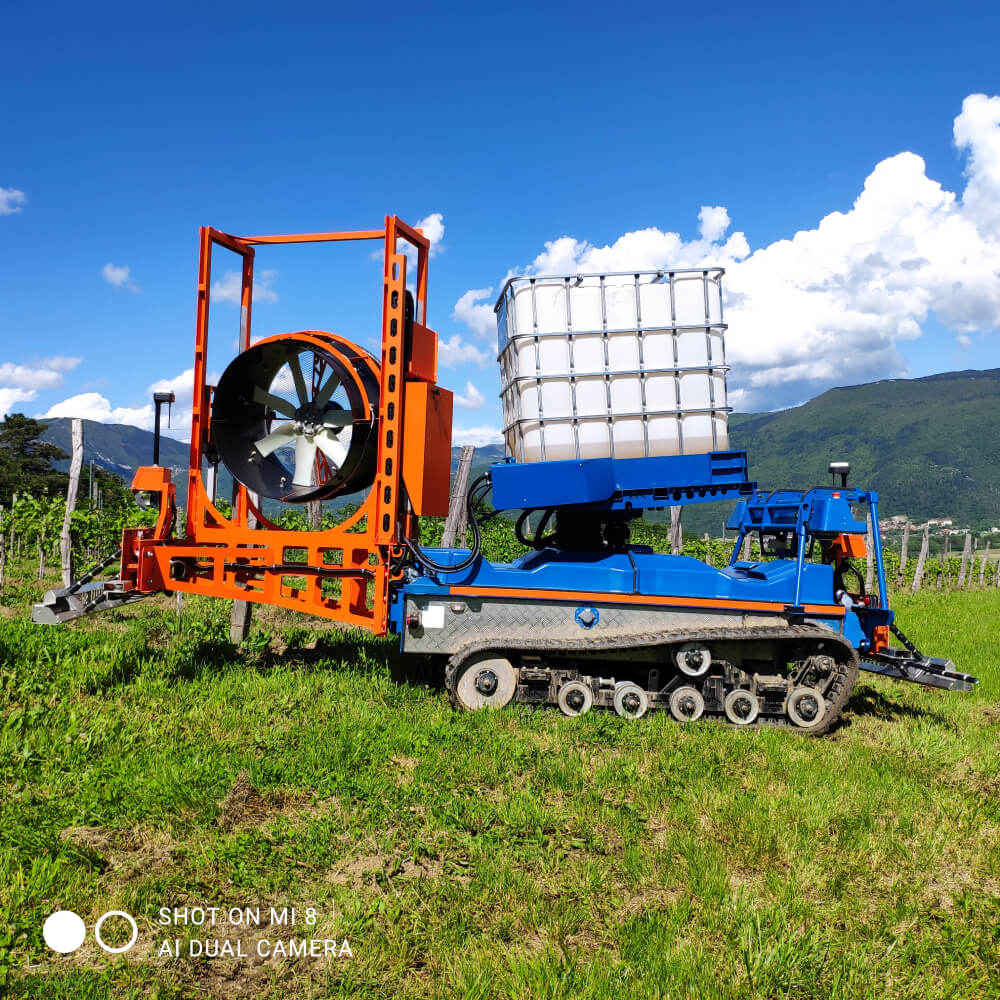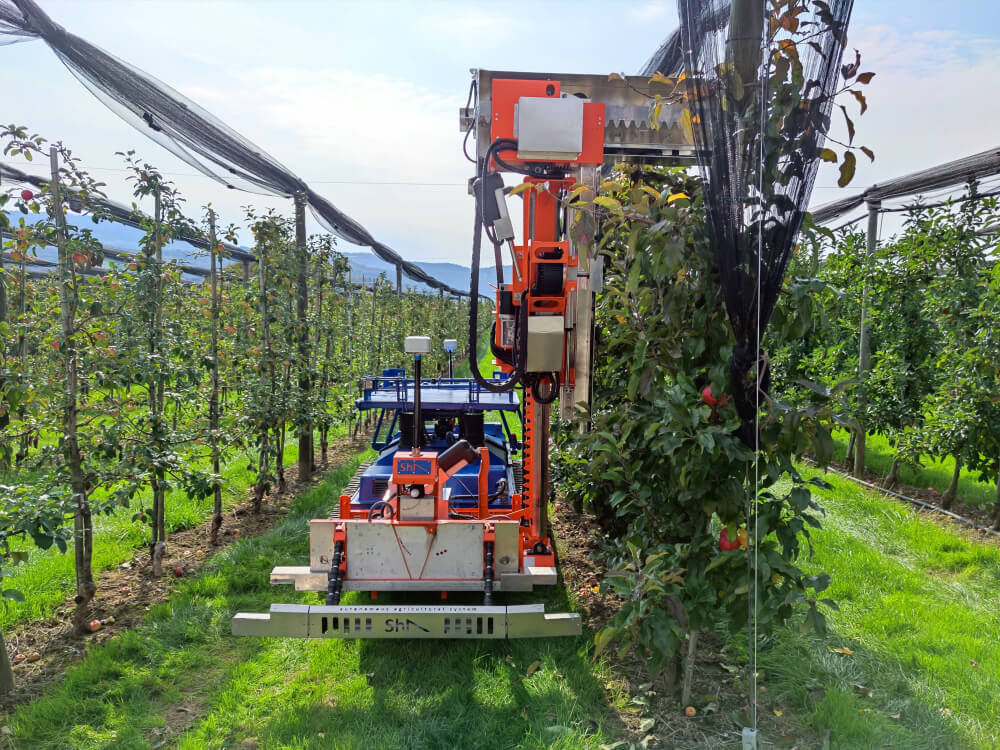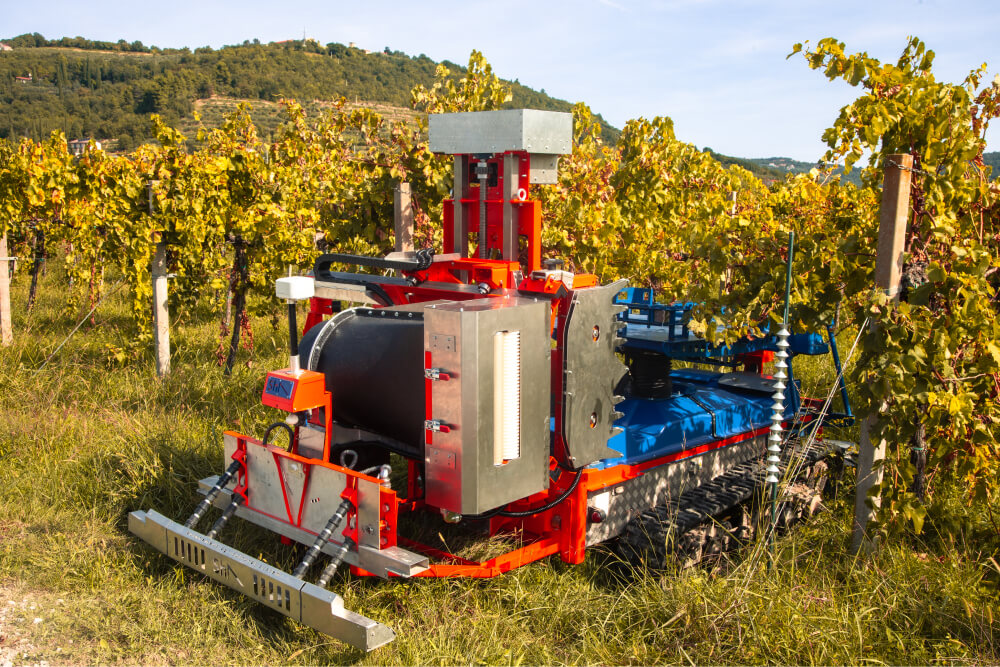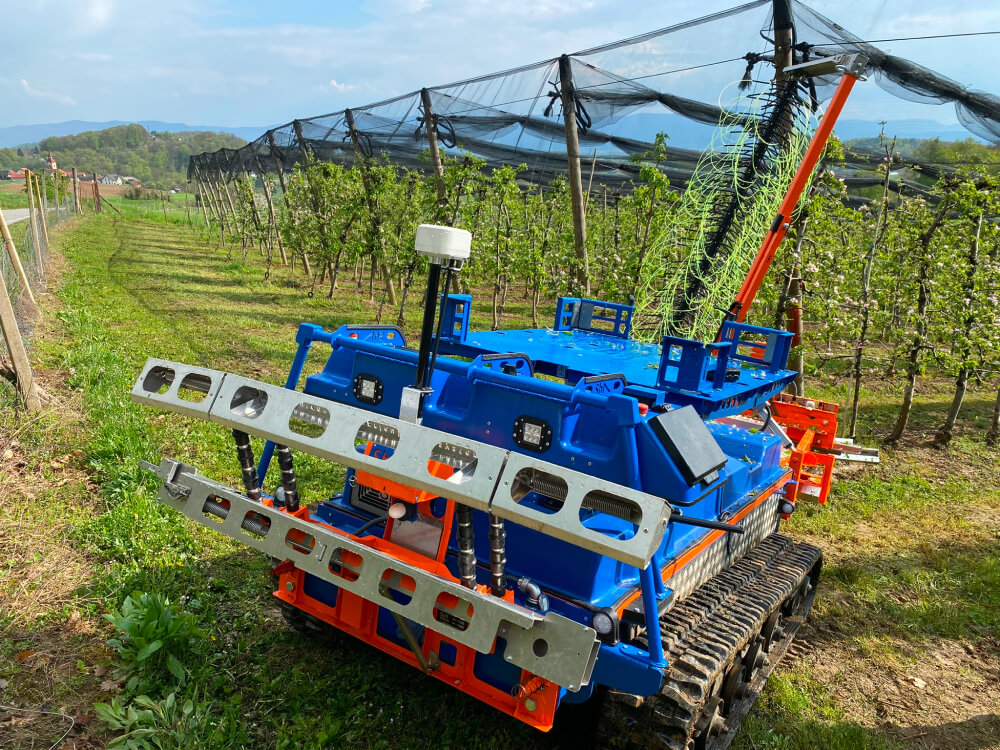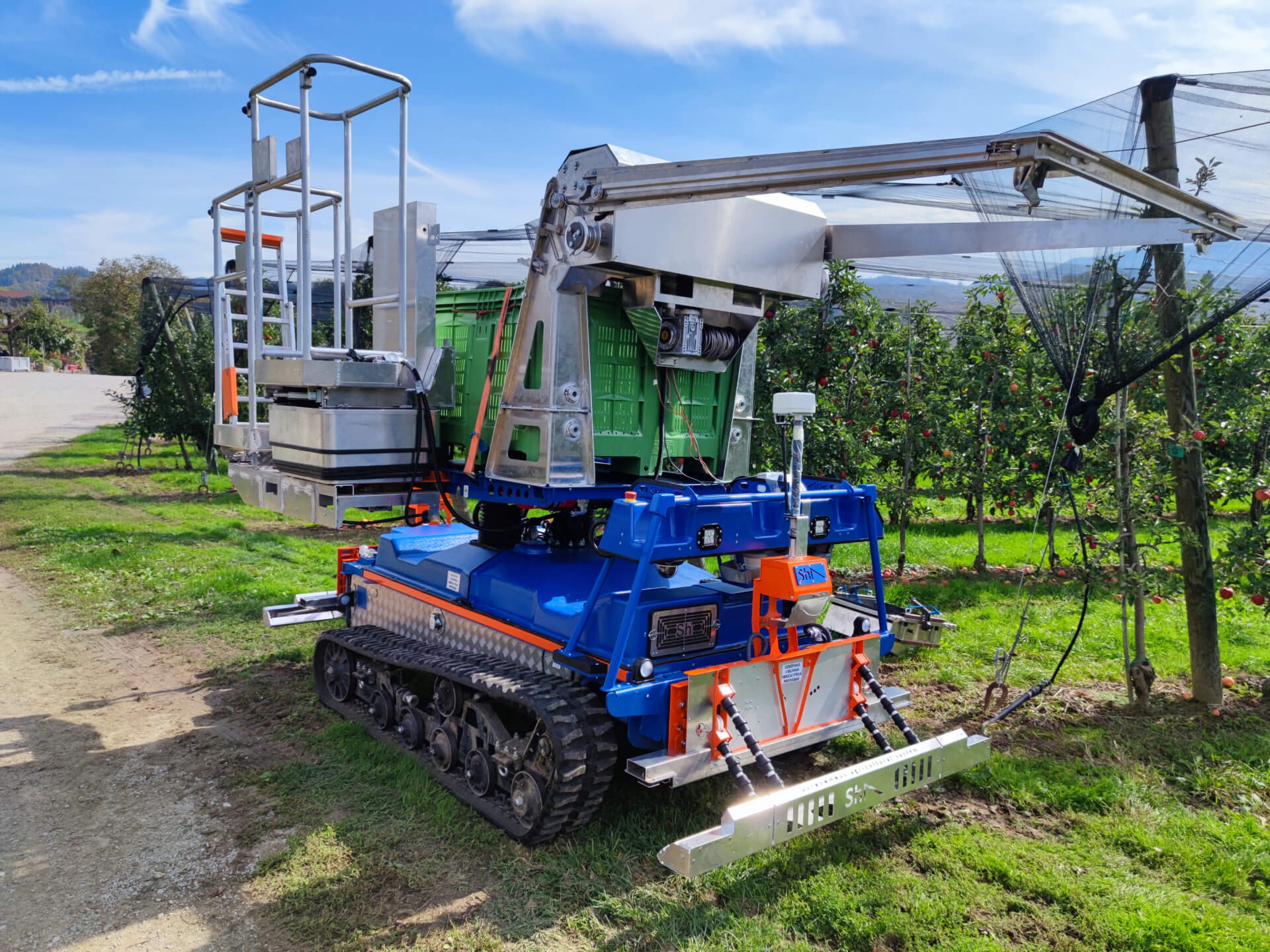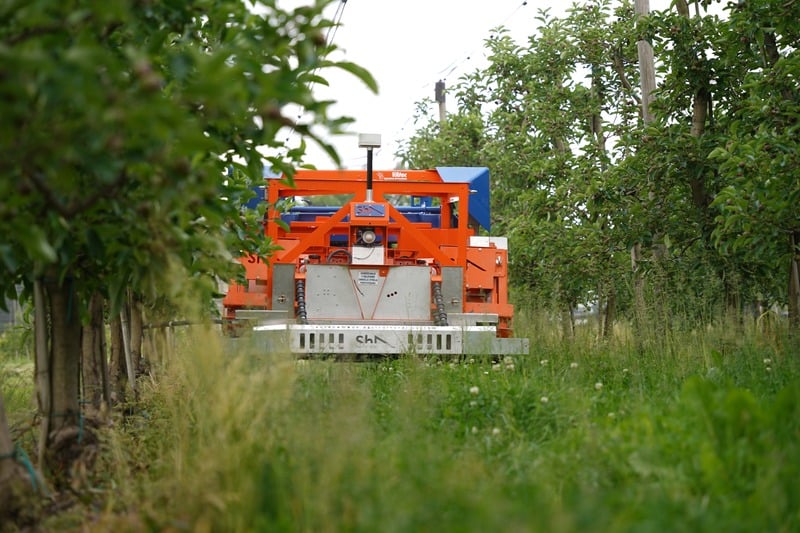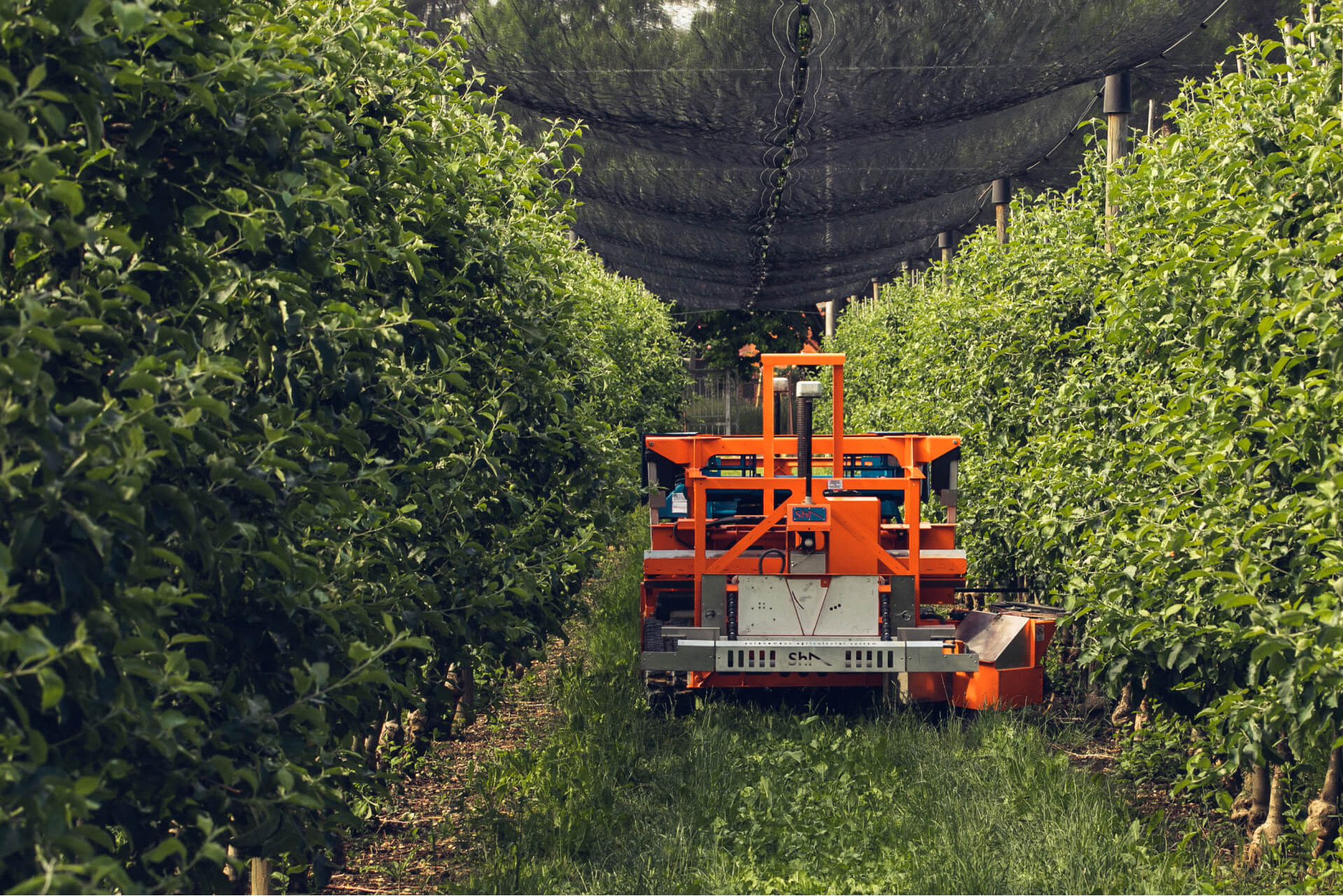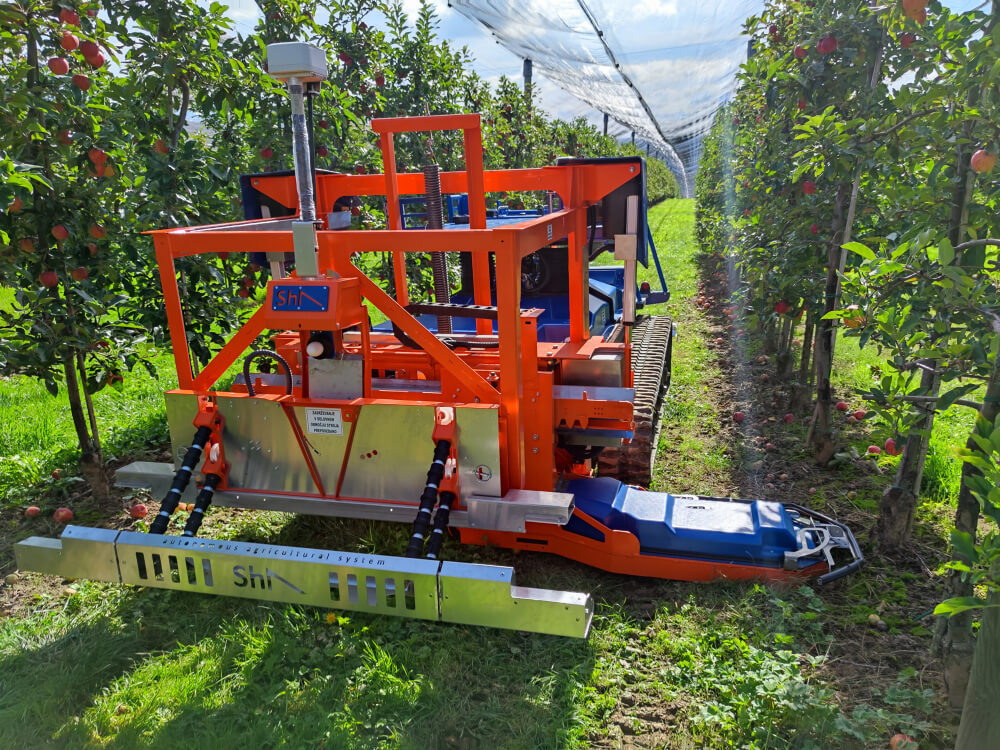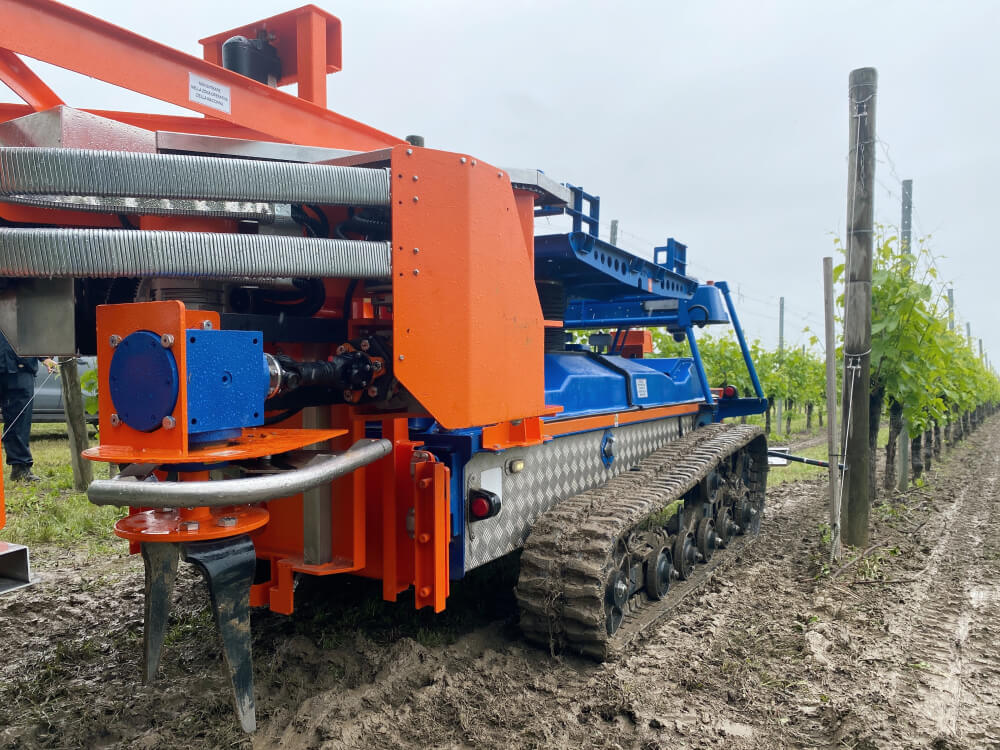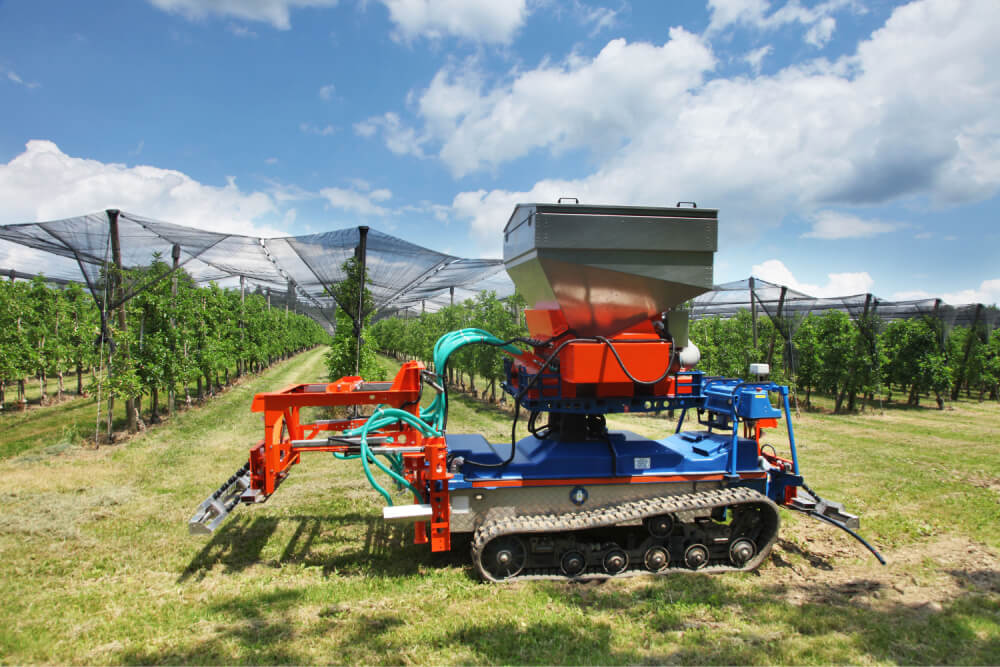Slopehelper Base Platform
The Base Platform is the core of the Slopehelper autonomous, low-voltage electric agrosystem. Designed for durability and efficiency, it operates autonomously in orchards and vineyards. Its modular design supports various attachments, ensuring seamless integration into the full farming cycle while reducing costs and environmental impact.
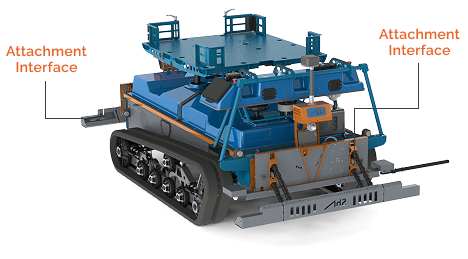
Gravity-Stabilized Cargo Platform
A unique feature of the cargo platform installed on top of the Base platform is its gravity-stabilized design. This innovative design ensures the stable operation of various equipment, such as harvesting shelves, sprayers, and fertilizers, even on inclined surfaces. It enhances both efficiency and adaptability, making it ideal for different terrains and tasks, ensuring reliable performance across all agricultural operations.
One Platform for Multiple Attachments
The Base Platform is the heart of the system, integrating:
✔ Transmission – Ensuring smooth and reliable movement.
✔ Electronics – Advanced controls for seamless operation.
✔ Power Unit – Delivering efficiency and endurance.
✔ Cargo Platform – A highly adaptable foundation.
Designed for maximum flexibility, attachments can be mounted at the front, rear, sides, or on top of the platform, adapting to various agricultural needs throughout the entire yearly agro-cycle.
🔧 With a wide range of interchangeable attachments, the Base Platform transforms into a multi-functional powerhouse for any farming operation.
Suspended Caterpillar Blocks
The Base platform features two suspended caterpillar blocks, providing exceptional operational capabilities in all weather conditions. This design reduces soil pressure by two times less than a conventional 120-horsepower tractor with low-pressure wheels, ensuring minimal soil compaction. With enhanced mobility and a focus on soil preservation, the Base platform offers reliable, sustainable performance in challenging agricultural environments.
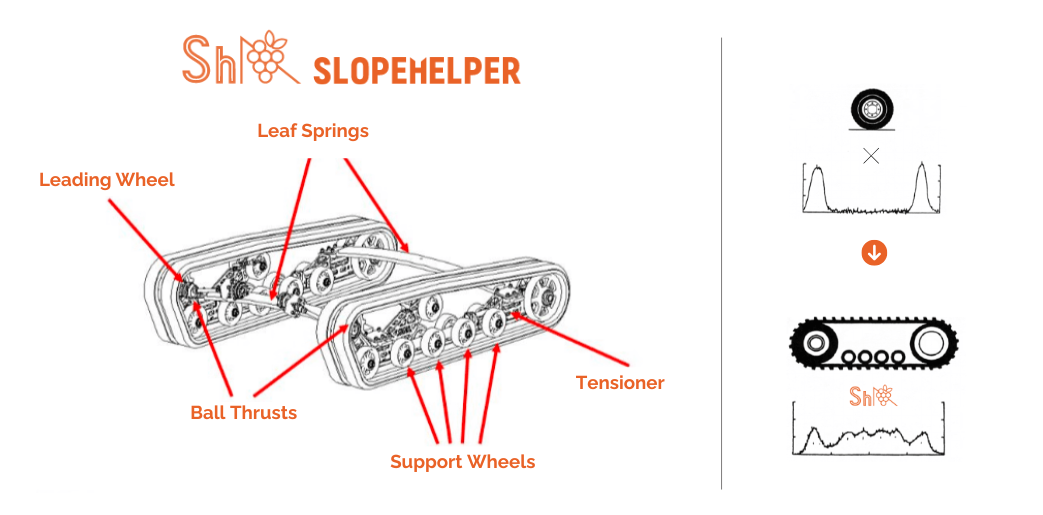
Slopehelper’s caterpillars exert twice less soil pressure than a traditional wheel-drive tractor, ensuring minimal soil compaction and better field preservation.
Features & Benefits
The Slopehelper is an advanced, fully autonomous agricultural robot that utilizes the cutting-edge R-WAVE Autonomous technology to operate independently in vineyards and orchards. By integrating R-WAVE RTK, GNSS, radar, and reflectors, the Slopehelper is capable of navigating plantation lines and seamlessly switching between rows without human intervention, providing a truly autonomous solution for modern farming.
How Slopehelper Utilizes R-WAVE Autonomous Technology:
-
Autonomous Navigation: The Slopehelper relies on the R-WAVE Autonomous system to create a detailed map of the plantation area, allowing it to navigate the terrain and perform tasks with precision, all without manual control.
-
No Need for Constant GNSS or RTK Signals: Once the initial map is generated, the Slopehelper can operate using radar and reflectors, eliminating the need for continuous GNSS or RTK signals. This makes it ideal for use in areas where such signals may be unreliable or unavailable.
-
Obstacle Detection: With the help of the R-WAVE 2D MP Radar, the Slopehelper detects obstacles in its path and ensures safe, uninterrupted movement throughout the plantation.
-
Precision Path Maintenance: The integration of encoders helps the Slopehelper maintain a correct path and distance from trees and vines, ensuring accuracy while working between rows.
Key Features of Slopehelper’s Autonomy:
-
Automatic Row Navigation: The system allows the Slopehelper to autonomously follow plantation lines, switching between rows with ease. It adapts to different shapes of rows, whether straight, curved, or terraced.
-
Self-Sufficient Operation: The Slopehelper operates without requiring a constant connection to GNSS or internet, making it a reliable and cost-effective solution for continuous fieldwork.
-
Precision and Efficiency: The R-WAVE Autonomous technology enables the Slopehelper to perform repetitive tasks with high efficiency and minimal errors, ensuring consistent results across diverse agricultural environments.
By utilizing R-WAVE Autonomous technology, the Slopehelper represents the future of autonomous farming—delivering precision, efficiency, and sustainability, all while reducing the need for manual labor and increasing overall productivity in the field.
The Slopehelper is equipped with R-WAVE RTK, a mobile Real-Time Kinematic (RTK) system that ensures centimeter-level accuracy (up to 10 mm) for precise and reliable autonomous navigation in agriculture. Here’s how R-WAVE RTK enhances the Slopehelper’s performance:
-
Precision Positioning:
- R-WAVE RTK improves the positioning accuracy of the Slopehelper by using a base station to send real-time correctional data to the rover, correcting any discrepancies in the GNSS signal caused by atmospheric, ionospheric, and weather-related factors. This ensures Slopehelper can navigate with exceptional precision.
-
RTK Navigation for Autonomous Operation:
- The RTK system enables the Slopehelper to perform autonomous tasks with pinpoint accuracy, making it ideal for repetitive operations in orchards and vineyards. The base station maintains a fixed position and communicates with multiple rovers, ensuring seamless and accurate operation in real-time.
-
All-Weather Operation:
- The Slopehelper, with R-WAVE RTK, performs reliably in all weather conditions, including low visibility and adverse weather. This ensures that the Slopehelper can operate year-round, even in challenging field environments, without compromising its performance.
-
Easy Setup and Long Battery Life:
- R-WAVE RTK provides an easy setup process for the Slopehelper, eliminating the need for intricate tuning or calibration. Once the satellite connection is established, the system is ready for operation. Additionally, the system can operate for up to a month without recharging, minimizing downtime in the field.
-
High Durability and Compact Design:
- The R-WAVE RTK system components, including the antenna, mapper, and base station, are designed to be compact, durable, and easy to transport, enabling quick deployment and flexibility in various field locations. These high-quality components ensure long service life, even in demanding agricultural conditions.
-
Enhanced GNSS Accuracy for Dynamic Mapping:
- The R-WAVE RTK system allows the Slopehelper to create precise maps and carry out surveying tasks in the field. The mobile receiver and optional handheld mapper offer dynamic mapping capabilities, making the Slopehelper not just an autonomous vehicle but also an essential tool for agricultural mapping and land management.
-
Optimized for Precision Agriculture:
- With R-WAVE RTK, the Slopehelper is specifically optimized for precision agriculture. This system provides highly accurate navigation for tasks like planting, soil sampling, and pesticide application, ensuring the efficient use of resources and improved crop yield.
-
Autonomous Operation Across Varied Terrains:
- R-WAVE RTK enhances the Slopehelper’s ability to operate autonomously in diverse terrains, such as straight rows, curved rows, and terraces. This allows the Slopehelper to adapt to different plantation types and continue its work seamlessly across various agricultural landscapes.
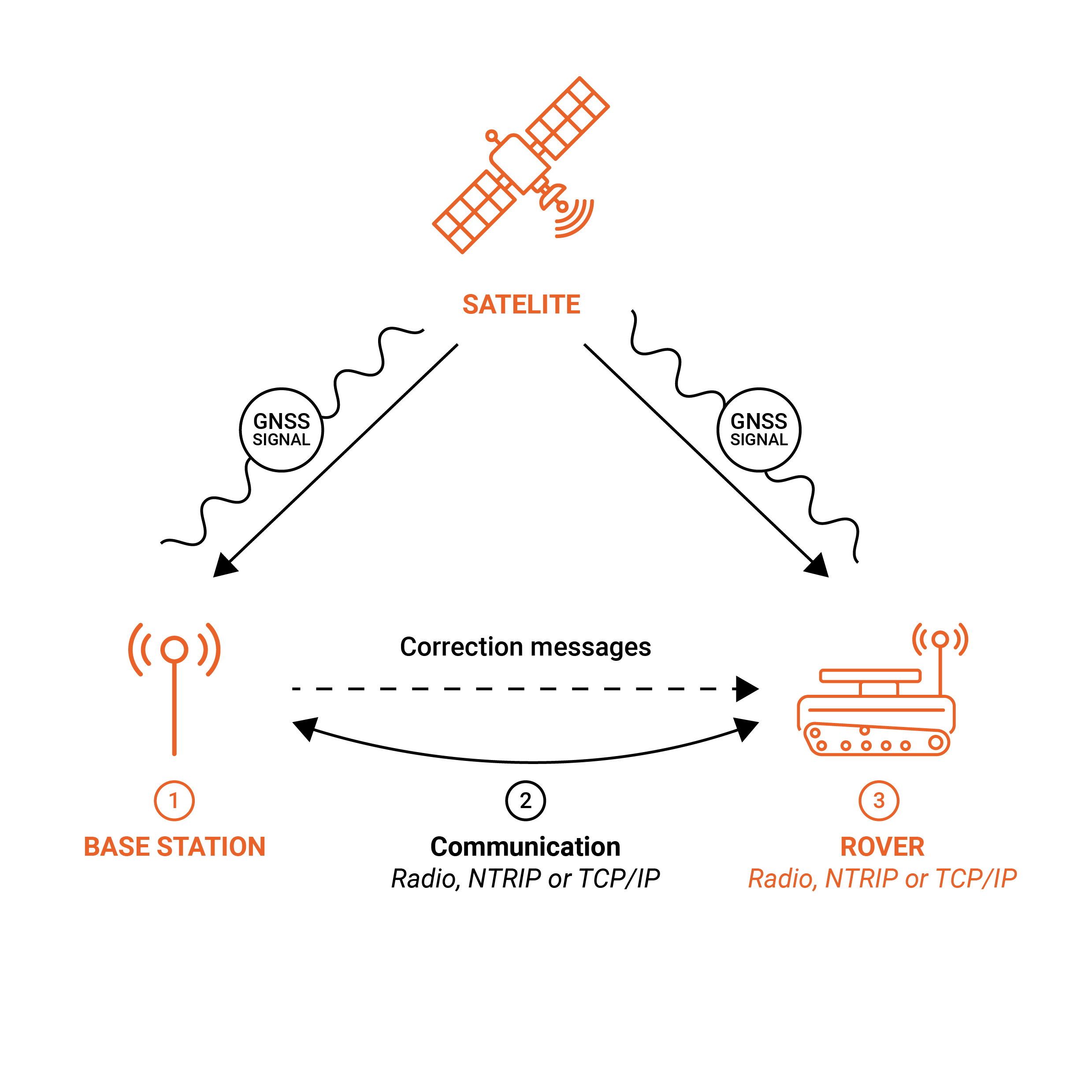
The Slopehelper is equipped with the R-WAVE 2D MP Radar, which plays a critical role in ensuring the vehicle operates autonomously, safely, and efficiently, even in challenging environments. The R-WAVE 2D MP Radar technology provides the Slopehelper with enhanced capabilities for obstacle avoidance, precise perception of its surroundings, and flawless navigation. Here’s a breakdown of how the radar works and the unique advantages it provides:
How the Radar Works:
The R-WAVE 2D MP Radar utilizes Radio Detection and Ranging (RADAR) technology, which emits radio waves to measure the distance to objects in the Slopehelper’s environment. Here’s the process:
-
Radio Wave Emission:
- The radar emits radio waves, which travel through the environment and bounce back when they encounter an object or surface.
-
Distance Measurement:
- The radar measures the time it takes for the waves to return. This time is used to calculate the distance to the object, providing an accurate sense of spatial awareness.
-
Speed Measurement (Doppler Effect):
- The radar can also measure the velocity of moving objects by detecting frequency shifts in the returning waves (known as the Doppler effect).
-
2D Terrain Mapping:
- Once the data is collected, it’s processed by an onboard computational unit, creating a 2D representation of the surrounding terrain. This map informs the Slopehelper’s autonomous driving system, helping it make precise navigational decisions.
Key Benefits & Advantages of the R-WAVE 2D MP Radar:
-
Obstacle Detection and Avoidance:
- The radar offers excellent obstacle detection capabilities, enabling the Slopehelper to navigate through complex terrains and avoid obstacles without human intervention. This ensures safe and efficient autonomous operation in various conditions.
-
Precise Detection:
- With a measurement precision of ±30 mm and a range of 0.5 to 6 meters, the R-WAVE 2D MP Radar provides highly accurate data for navigation and obstacle avoidance.
-
Low False Positive Rate:
- The radar system has a low false positive rate, meaning it reduces unnecessary maneuvers or interventions. This enhances the overall reliability and efficiency of the Slopehelper in performing its tasks autonomously.
-
All-Weather Operation:
- The radar operates reliably in all weather conditions, including rain, fog, snow, and low visibility. This is crucial for maintaining uninterrupted operations, even during adverse weather or in environments with limited visibility.
-
Robustness:
- The R-WAVE 2D MP Radar is more durable than optical sensors and is less sensitive to dust, dirt, and vibrations. This makes it ideal for use in rugged agricultural environments, where the Slopehelper can encounter challenging terrains and conditions.
Enhanced Navigation in Challenging Environments:
Thanks to the R-WAVE 2D MP Radar, the Slopehelper is equipped with superb navigation capabilities. This radar technology is essential for:
- Navigating complex terrain, such as uneven rows or curving paths in vineyards and orchards.
- Ensuring precise navigation in low-visibility conditions (e.g., early mornings with fog or during rainy weather).
- Safely performing repetitive tasks such as weeding, spraying, or harvesting without risk of colliding with obstacles.
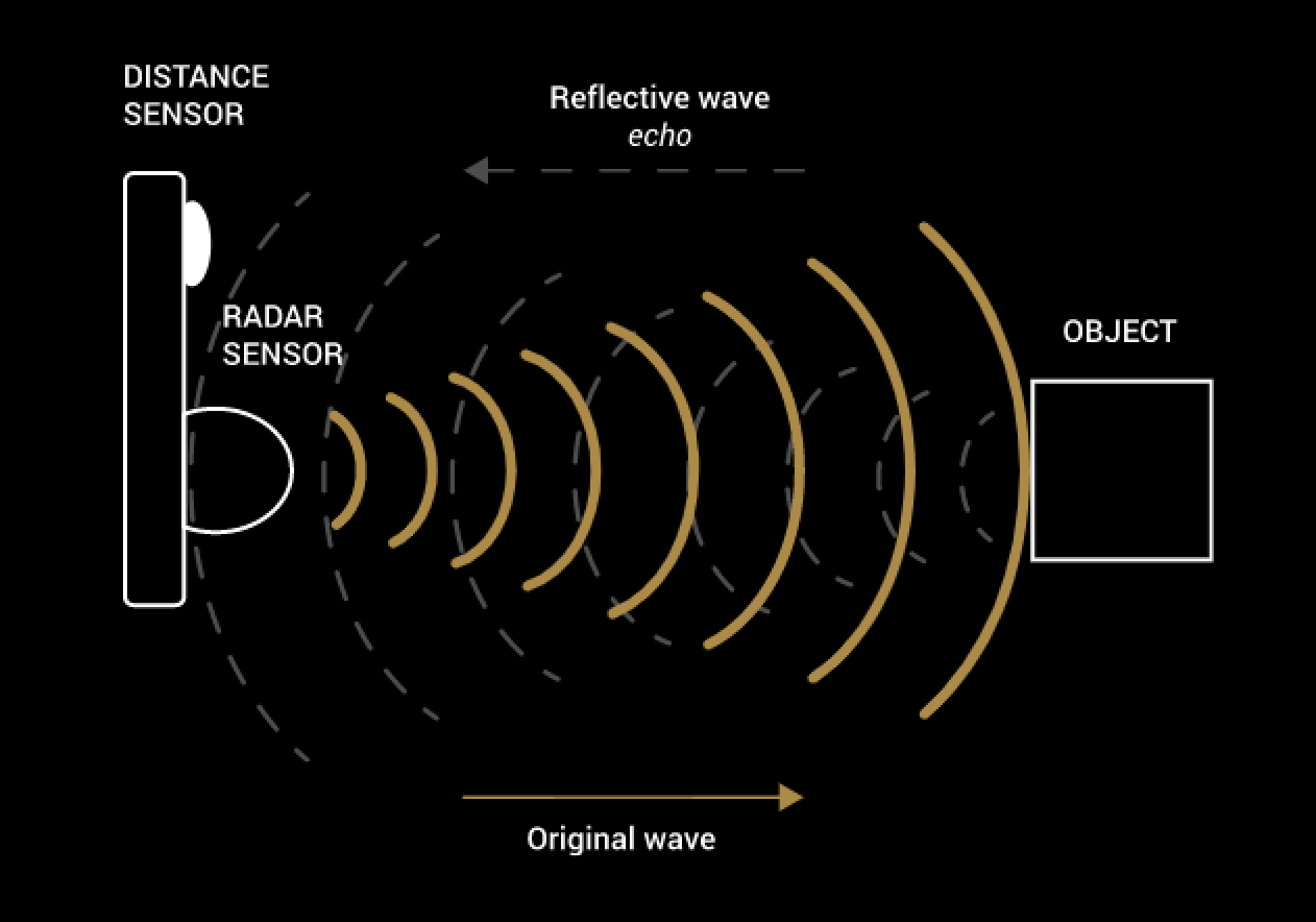
TeroAir enhances the operation of the Slopehelper machine by enabling farmers to optimize performance, ensure efficient resource management, and make data-driven decisions in real time.
-
Real-Time Monitoring and Data Integration: TeroAir integrates with the sensors and GPS systems on Slopehelper to monitor soil moisture, terrain conditions, and other environmental factors. This ensures that the machine operates at its optimal efficiency, adjusting to real-time data for precise soil and crop management.
-
Unified Connectivity Across Operations: As farmers use Slopehelper, TeroAir allows them to stay connected with agronomists and suppliers. This enables seamless communication about crop needs and machinery performance, making it easier to coordinate tasks like irrigation scheduling, fertilization, and pest management.
-
Smart Resource Management: By analyzing historical and real-time data, TeroAir helps farmers optimize the use of resources such as water, fuel, and labor. It provides insights on when and where to deploy Slopehelper, minimizing waste and improving overall productivity.
-
Precision Agriculture: TeroAir supports Slopehelper by providing detailed analysis of field conditions, which helps farmers make precise adjustments in real time. This ensures Slopehelper can adapt to varying terrain and crop conditions, maximizing yield and reducing environmental impact.
-
Cloud-Based Scalability: Whether managing a small farm or large agricultural enterprise, TeroAir’s cloud infrastructure ensures that farmers have remote access to critical data. This scalability allows for efficient operation across different farm sizes while maintaining consistent control over Slopehelper’s performance.
Key Benefits for Farmers:
- Enhanced Productivity: Real-time insights from TeroAir keep Slopehelper running efficiently, reducing downtime and improving task execution.
- Cost Savings: Optimized resource management reduces waste, improves fuel efficiency, and ensures the right resources are allocated at the right time.
- Sustainable Farming: TeroAir promotes eco-friendly practices by ensuring that Slopehelper is used in the most efficient way, minimizing environmental impact.
- Data-Driven Decisions: TeroAir’s integrated platform provides farmers with actionable data, allowing them to make better-informed decisions for their crops and machinery.
Real-Time Environmental Data for Smarter Farming
The R-WAVE Weather Station, integrated into the TeroAir Smart System, provides farmers with real-time weather data directly on their smartphones. This technology enables more informed decision-making and optimized farm operations.
Key Benefits of the R-WAVE Weather Station
-
Real-Time Monitoring: Farmers can view critical weather conditions such as temperature, humidity, wind speed, and precipitation on their smartphones, allowing for quick responses to changing field conditions.
-
Optimized Resource Management: By monitoring weather patterns, the system helps manage irrigation and resource use efficiently, conserving water and reducing costs.
-
Pest & Disease Management: The station tracks conditions that influence pests and diseases, helping farmers apply preventive measures at the right time to protect crops.
-
Improved Crop Management: Accurate weather data supports better decisions on planting, harvesting, and crop protection, avoiding risks like frost or drought.
-
Seamless Integration with Autonomous Systems: When paired with autonomous systems like Slopehelper, the weather data helps adjust field operations based on current conditions, enhancing efficiency.
The R-WAVE Weather Station, integrated with the TeroAir Smart System, empowers farmers with real-time weather data, leading to smarter decisions, better resource management, and improved crop outcomes. This system is a key tool for precision farming, boosting productivity and sustainability.






